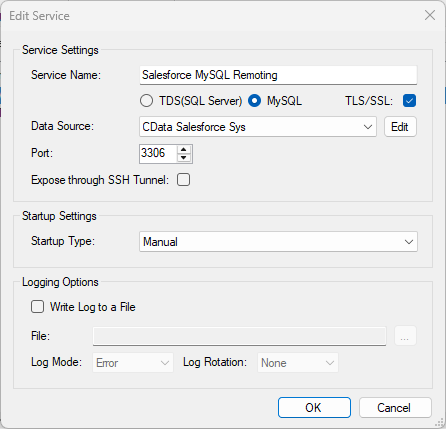Model Context Protocol (MCP) finally gives AI models a way to access the business data needed to make them really useful at work. CData MCP Servers have the depth and performance to make sure AI has access to all of the answers.
Try them now for free →How to create Adobe Analytics federated tables in MySQL
Use the SQL Gateway and the ODBC Driver to set up federated tables for Adobe Analytics data in MySQL .
You can use the SQL Gateway to configure a MySQL remoting service and set up federated tables for Adobe Analytics data. The service is a daemon process that provides a MySQL interface to the CData ODBC Driver for Adobe Analytics: After you have started the service, you can create a server and tables using the FEDERATED Storage Engine in MySQL. You can then work with Adobe Analytics data just as you would local MySQL tables.
Connect to Adobe Analytics Data
If you have not already done so, provide values for the required connection properties in the data source name (DSN). You can use the built-in Microsoft ODBC Data Source Administrator to configure the DSN. This is also the last step of the driver installation. See the "Getting Started" chapter in the help documentation for a guide to using the Microsoft ODBC Data Source Administrator to create and configure a DSN.
Adobe Analytics uses the OAuth authentication standard. To authenticate using OAuth, you will need to create an app to obtain the OAuthClientId, OAuthClientSecret, and CallbackURL connection properties. See the "Getting Started" section of the help documentation for a guide.
Retrieving GlobalCompanyId
GlobalCompanyId is a required connection property. If you do not know your Global Company ID, you can find it in the request URL for the users/me endpoint on the Swagger UI. After logging into the Swagger UI Url, expand the users endpoint and then click the GET users/me button. Click the Try it out and Execute buttons. Note your Global Company ID shown in the Request URL immediately preceding the users/me endpoint.
Retrieving Report Suite Id
Report Suite ID (RSID) is also a required connection property. In the Adobe Analytics UI, navigate to Admin -> Report Suites and you will get a list of your report suites along with their identifiers next to the name.
After setting the GlobalCompanyId, RSID and OAuth connection properties, you are ready to connect to Adobe Analytics.
Configure the SQL Gateway
See the SQL Gateway Overview to set up connectivity to Adobe Analytics data as a virtual MySQL database. You will configure a MySQL remoting service that listens for MySQL requests from clients. The service can be configured in the SQL Gateway UI.

Create a FEDERATED Server and Tables for Adobe Analytics Data
After you have configured and started the service, create a FEDERATED server to simplify the process of creating FEDERATED tables:
Create a FEDERATED Server
The following statement will create a FEDERATED server based on the ODBC Driver for Adobe Analytics. Note that the username and password of the FEDERATED server must match a user account you defined on the Users tab of the SQL Gateway.
CREATE SERVER fedAdobeAnalytics FOREIGN DATA WRAPPER mysql OPTIONS (USER 'sql_gateway_user', PASSWORD 'sql_gateway_passwd', HOST 'sql_gateway_host', PORT ####, DATABASE 'CData AdobeAnalytics Sys');
Create a FEDERATED Table
To create a FEDERATED table using our newly created server, use the CONNECTION keyword and pass the name of the FEDERATED server and the remote table (AdsReport). Refer to the following template for the statement to create a FEDERATED table:
CREATE TABLE fed_adsreport ( ..., page TYPE(LEN), pageviews TYPE(LEN), ..., ) ENGINE=FEDERATED DEFAULT CHARSET=latin1 CONNECTION='fedAdobeAnalytics/adsreport';
NOTE: The table schema for the FEDERATED table must match the remote table schema exactly. You can always connect directly to the MySQL remoting service using any MySQL client and run a SHOW CREATE TABLE query to get the table schema.
Execute Queries
You can now execute queries to the Adobe Analytics FEDERATED tables from any tool that can connect to MySQL, which is particularly useful if you need to JOIN data from a local table with data from Adobe Analytics. Refer to the following example:
SELECT fed_adsreport.page, local_table.custom_field FROM local_table JOIN fed_adsreport ON local_table.foreign_page = fed_adsreport.page;

